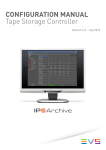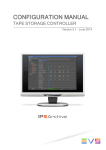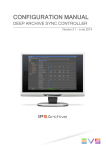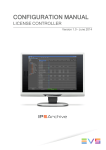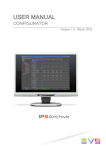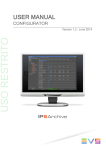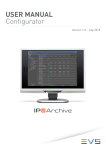Download Tape Storage Controller
Transcript
Configuration Manual Version 4.0 - October 2012 Tape Storage Controller Archive Digitization & Exploitation IP2Archive - Configuration Manual - Tape Storage Controller Version 4.0 Copyright EVS Broadcast Equipment S.A.– Copyright © 2003-2012. All rights reserved. Disclaimer The information in this manual is furnished for informational use only and subject to change without notice. While every effort has been made to ensure that the information contained in this user manual is accurate, up-to-date and reliable, EVS Broadcast Equipment cannot be held responsible for inaccuracies or errors that may appear in this publication. Improvement Requests Your comments will help us improve the quality of the user documentation. Do not hesitate to send improvement requests, or report any error or inaccuracy on this user manual by e-mail to [email protected]. Regional Contacts The address and phone number of the EVS headquarters are usually mentioned in the Help > About menu in the user interface. You will find the full list of addresses and phone numbers of local offices either at the end of this user manual (for manuals on hardware products) or at the following page on the EVS website: http://www.evs.tv/contacts. User Manuals on EVS Website The latest version of the user manual, if any, and other user manuals on EVS products can be found on the EVS download center, on the following webpage: http://www.evs.tv/downloadcenter. I EVS Broadcast Equipment S.A. - October 2012 Issue 4.0.D Table of Contents 1. 2. 3. What's New III INTRODUCTION 1 1.1. About the Application 1 STARTING THE APPLICATION 2 2.1. Start-up Procedure 2 2.1.1. After Installation 2 2.1.2. After Configuration 2 2.2. Main Window Overview 3 2.3. Overview Tasks Tape Storage Controller 5 CONFIGURING THE APPLICATION 6 3.1. Settings Window 6 3.1.1. Opening the Settings Window 6 3.1.2. Overview Setup Categories 7 3.1.3. Edit Mode 7 3.2. User Settings 7 3.2.2. Overview User Settings Subcategories 7 3.2.3. MAD Tab 8 3.3. System Settings II 7 3.2.1. Accessing the User Settings 8 3.3.1. Accessing the System Settings 8 3.3.2. Overview System Settings Subcategories 8 3.3.3. MAD Options Tab 9 3.3.4. Oracle Connection Tab 11 3.3.5. E-Mail Options Tab 13 3.3.6. Timers Tab 15 3.3.7. Tasks Tab 15 3.3.8. Global Password Tab 15 3.3.9. Error Handling Tab 16 3.3.10. HSMs Tab 17 3.3.11. DIVA Tab 18 IP2Archive - Configuration Manual - Tape Storage Controller Version 4.0 What's New The changes linked to new features in version 4.0. are listed in the table below. In the the icon has been added in the left margin to highlight information on new and updated features. Click the section number in the table to jump directly to the corresponding section. Section Description 3.3.10, 3.3.11, HSMs are configured in a separate tab. DIVA host, port, login and password can be edited. III EVS Broadcast Equipment S.A. - October 2012 IV Issue 4.0.D IP2Archive - Configuration Manual - Tape Storage Controller Version 4.0 1. Introduction 1.1. About the Application IP2Archive Tape Storage Controller is an automated application or robot that interacts with the hierarchical storage management system to drive all the archive, (partial) restore and purge requests originating from IPDirector and the IP2Archive Deep Archive Manager. 1. Introduction 1 EVS Broadcast Equipment S.A. - October 2012 2. Starting the Application 2.1. Start-up Procedure 2.1.1. After Installation Issue 4.0.D Double-click the IP2Archive Tape Storage Controller icon on the desktop of the application server to start the application. You can also start the application by doubleclicking the executable file (.exe) in the installation folder. The splash screen appears. The application logs into the database. Then, the Settings window appears allowing you to configure the application. See section "Settings Window" on page 6. 2.1.2. After Configuration Double-click the IP2Archive Tape Storage Controller icon on the desktop of the application server to start the application. You can also start the application by doubleclicking the executable file (.exe) in the installation folder. The splash screen appears. The application logs into the database. Then, the main window opens. After a time interval defined in the settings, the application automatically starts performing its various tasks. 2 2. Starting the Application IP2Archive - Configuration Manual - Tape Storage Controller Version 4.0 2.2. Main Window Overview The major areas of the main window are highlighted in the screenshot below. (1) Menu Bar The menu bar contains three menus: File, Settings and Help. The File menu contains only one command: Exit. It is used to exit the application. Click the File menu or use the keyboard shortcut keys ALT + F or F10 + F to open it. Click Exit or use the keyboard shortcut key X to exit the application. The Settings menu doesn’t contain any commands. It immediately gives access to the application settings. Click the Settings menu or use the keyboard shortcut keys ALT + S or F10 + S to access the settings. The Help menu contains only one command: About. With this command the application splash screen can be opened. The splash screen displays the application software version, the name of the database the application is logged on to and the login name used. Click the Help menu or use the keyboard shortcut keys ALT + H or F10 + H to open it. Click About or use the keyboard shortcut key A to open the splash screen. These menus only become available after you have clicked the Stop button. (2) Tasks Pane The Tasks pane displays the number, name and description of the tasks performed by the 2. Starting the Application 3 EVS Broadcast Equipment S.A. - October 2012 Issue 4.0.D application. Only the tasks that were activated in the System settings will be performed at start-up. If you want to manually run certain tasks for test purposes, you have to stop the application, select the corresponding check box in the Active column, and then click the Start button. This button only becomes available after you have clicked the Stop button. See section "Tasks Tab" on page 15. (3) Start/Stop Buttons These buttons are used to manually start and stop the application. (4) Log Pane The Log pane lists application events and can be useful when you are trying to verify that automations are working correctly. The date and time of each event is displayed. 4 2. Starting the Application IP2Archive - Configuration Manual - Tape Storage Controller Version 4.0 2.3. Overview Tasks Tape Storage Controller The table below gives a brief description of the tasks performed by IP2Archive Tape Storage Controller. Number Task Description 1 Synchronize When interfacing with Front Porch Digital Archive Searches in the DIVArchive database for the number of Database groups and LTO tapes present in the LTO tape library and synchronizes this with the IP2Archive database. 2 Request Backup When interfacing with Front Porch Digital Archive Checks the IP2Archive database for archive requests and commands the DIVA Manager to start the archiving process. 3 Request Restore When interfacing with Front Porch Digital Archive Checks the IP2Archive database for restore requests and commands the DIVA Manager to start the restore process. 4 Request Purge When interfacing with Front Porch Digital Archive Checks the IP2Archive database for purge requests and commands the DIVA Manager to start the purge process. 5 Synchronize When interfacing with Front Porch Digital Archive Searches in the DIVArchive database for the number of Database groups and LTO tapes present in the LTO tape library and synchronizes this with the IP2Archive database. 6 Update Backup Progress When interfacing with Front Porch Digital Archive Checks the status and progress of the archive jobs and synchronizes this information with the IP2Archive database. 7 Update Restore Progress When interfacing with Front Porch Digital Archive Checks the status and progress of the restore jobs and synchronizes this information with the IP2Archive database. 8 Update Purge Progress When interfacing with Front Porch Digital Archive Checks the status and progress of the purge jobs and synchronizes this information with the IP2Archive database. Note For performance reasons, two or more instances of the Tape Storage Controller can be installed. Each instance can be configured to perform only a specif set of the tasks mentioned above. For example, there could be an instance that only performs the archive and purge tasks, and an instance that only performs the restore tasks. 2. Starting the Application 5 EVS Broadcast Equipment S.A. - October 2012 Issue 4.0.D 3. Configuring the Application 3.1. Settings Window 3.1.1. Opening the Settings Window The Settings window allows you to configure your application. The first time the application is launched after it has been installed, the Settings window opens automatically. The Settings window can also be accessed through the Settings menu. To make this menu available, click the Stop button. The application will stop performing its tasks. 6 3. Configuring the Application IP2Archive - Configuration Manual - Tape Storage Controller Version 4.0 3.1.2. Overview Setup Categories The settings can be divided into three setup categories. In the Settings window, a tab is provided for each setup category. The table below briefly describes each setup category: Setup Category Description User Settings These settings can be configured by each individual user. Global Settings These settings can only be configured by the system administrator and by an eventual superuser. System Settings These settings configure the general functioning of the application. They can only be configured by the system administrator. Currently, only the User Settings and System Settings tab contain settings. The Global Settings tab is still empty. It does not contain any settings. 3.1.3. Edit Mode To be able to edit the Global and System settings, you first have to enter a password. To put the Settings window into Edit Mode, proceed as follows: 1. Click the Enter Into Edit Mode button . A dialog box appears. 2. Enter the administrator password and then click OK. The Settings window enters into Edit Mode. 3.2. User Settings 3.2.1. Accessing the User Settings The User settings can be accessed by clicking the User Settings tab in the Settings window. 3.2.2. Overview User Settings Subcategories The User settings are divided into the following subcategories: 3. Configuring the Application 7 EVS Broadcast Equipment S.A. - October 2012 • Issue 4.0.D MAD For each subcategory a tab is provided. 3.2.3. MAD Tab If you select the check box If Video File Is Not Found, Search in Paths, you can add one or more paths of storage folders the HSM system has to look for video files, if it does not find them on the nearline storage. In the Maximum Requests field you can enter the maximum number of archive or restore requests that can simultaneously be processed by the HSM system. The HSM system will wait until one of these requests has been processed before starting a new request. 3.3. System Settings 3.3.1. Accessing the System Settings The System settings can be accessed by clicking the System Settings tab in the Settings window. 3.3.2. Overview System Settings Subcategories The System settings are divided into the following subcategories: 8 • Directories • MAD Options • Oracle Connection • E-Mail Options • Timers • Tasks • Global Password • Error Handling 3. Configuring the Application IP2Archive - Configuration Manual - Tape Storage Controller Version 4.0 • HSMs • DIVA For each subcategory a tab is provided. The Directories tab is empty. It doesn't contain any settings. 3.3.3. MAD Options Tab The MAD Options tab allows you to configure the log file management, and the archive and restore process. Configuring the Archive Process If the setting Smart Sort Requests by Group is enabled, IP2Archive Tape Storage Controller will command DIVArchive Manager to sort all archive requests by group. When requests of the same group are processed sequentially, the tape robot won’t have to change tapes that often. However, the priority level of the files won’t be considered then. This setting can be disabled in case there are multiple DIVArchive actors and requests of different groups can be processed simultaneously. If the setting Do Not Archive to Empty Tape If There Is an Ejected Tape With Space Left is enabled, IP2Archive Tape Storage Controller will command the hierarchical storage management system to first check the LTO tape library for ejected tapes with space left before archiving files. If there are ejected tapes with space left, the hierarchical storage management system will wait until one of these tapes is available again in the LTO tape library to archive the files. If there are no ejected tapes with space left, the files 3. Configuring the Application 9 EVS Broadcast Equipment S.A. - October 2012 Issue 4.0.D will be archived to an empty tape that is present in the LTO tape library. If this setting is disabled, this check is not performed. If the setting Mark File as ‘Archived’ Only After It Has Been Written to Tape is enabled, IP2Archive Tape Storage Controller will wait to mark a file as being archived in the IP2Archive database until the file has been written to LTO tape. In the Deep Archive Manager GUI the file will then be moved to the Archived tab only after the file has been written to LTO tape. If the setting Check if Source File Exists is enabled, IP2Archive Tape Storage Controller will first check if the file to be archived really exists. If the file doesn't exist, it will not start the archive process. Clear this setting if Tape Storage Controller has no access to the storage location of the source file. If the setting Archive EVS Metadata XML File If Present is selected, IP2Archive Tape Storage Controller will command the hierarchical storage management system to also archive the EVS metadata XML file. In the Extension field you have to enter the default extension of the EVS metadata XML file, i.e. .evs.xml. This will prevent the hierarchical storage management system from archiving other types of XML files. If the setting Report Error If Metadata File Does Not Exist is not selected and no metadata file is found, only the video file is archived. If the setting is selected and no metadata file is found, the archive process will go into error. Configuring the Restore Process If the setting Smart Sort Requests by Group is enabled, IP2Archive Tape Storage Controller will command DIVArchive Manager to sort all restore requests by group. When requests of the same group are processed sequentially, the tape robot won’t have to change tapes that often. However, the priority level of the files won’t be considered then. This setting can be disabled in case there are multiple DIVArchive actors and requests of different groups can be processed simultaneously. Configuring Log File Management To be able to configure the log file management, you have to select the Log Files check box. In the Directory field you can enter the path of the log storage directory or you can browse for it by clicking . If you leave this field empty, the application will automatically create a default directory: C:\EVSLogs\MAD\[Application name]. If the A New Log Every Day check box is selected, a new log is started every day. You can also specify a time interval (in days) after which the logs should be removed from the log storage directory. If you enter ‘-1’, the logs are never removed from the storage directory. Configuring LogMemo Size In the LogMemo group box you can specify the maximum number of lines retained by the Log pane. 10 3. Configuring the Application IP2Archive - Configuration Manual - Tape Storage Controller Version 4.0 3.3.4. Oracle Connection Tab The Oracle Connection tab allows you to configure the connection with the Oracle database. Entering the Database Name In this field you have to enter the name of the database the application has to connect to. If the Use This Database Name check box is selected, the name of the database will automatically appear in the Oracle login dialog box at start-up. Entering the Login Name In this field you have to enter a login name. If the Use This Login Name check box is selected, the login name will automatically appear in the Oracle login dialog box at startup. Entering a Password In this field you have to enter a password. If the Use Auto Login check box is selected, the application automatically logs into the selected database at start-up. The Oracle login 3. Configuring the Application 11 EVS Broadcast Equipment S.A. - October 2012 Issue 4.0.D dialog box does not appear. Activating Version Control If the Use Version Control check box is selected, the software version of the application is checked each time it logs into the database. This check box should always be selected!! If the software version is outdated, the following warning message appears in the splash screen highlighted in red: ‘Obsolete – A newer version exists. May not be used anymore.’ Click the OK button to close the splash screen and update your software version. By clicking the Application History button, you can open a chronological list of all software versions of the application. To get more details about each version (creation date, name of programmer, status, additional remarks), you have to click + next to the version number. Activating Keep Alive If the option Keep Connection Alive is selected, a message is sent to the database at regular time intervals to avoid idle connections from being closed by the firewall. These intervals can be set by you. If the option Try to Reconnect if Keep Alive Fails is selected, the application will try a number of times to reconnect with the database. If the option Report Status in Database Everytime Keep Alive Timer Triggers is selected, the status of the connection is reported in the database each time the Keep Alive Timer sends a trigger to send a Keep Connection Alive message. If the option Report Status of Tasks is selected, the status of the tasks (ok or not ok) is reported to the database. Testing the Oracle Connection The Test Oracle button allows you to check the validity of the database name, login and username you entered. If these data are valid, then the following message appears next to the Test Oracle button: ‘OK’. If the login name or password is invalid, then a message box appears with the following message: ‘ORA-01017: invalid username/password; logon denied’. If the database name is invalid, then a message box appears with the following message: ‘ORA-12154:TNS: could not resolve the connect identifier specified’. If you omit the password, then a message box appears with the following message: ‘ORA-01005: null password given; logon denied’. If you don’t enter a database name, login and username, then a message box appears with the following message: ‘ORA-12560: TNS: protocol adapter error’. If the Use Version Control check box is selected, you can also check the software version of the application by clicking the Test Oracle button. If the software version is upto-date, then the following message appears: ‘Actual – The Actual Version’. If the software 12 3. Configuring the Application IP2Archive - Configuration Manual - Tape Storage Controller Version 4.0 version is outdated, then the following message appears: ‘Unknown Version Application! Please contact the EDP department.’ If you close the Settings window without testing the validity of the database name, login and username you just entered, then a message box appears. If you click Yes, then the Settings window is closed and the original values are restored. If you click Cancel, then the Settings window doesn’t close and you can test the values by clicking the Test Oracle button. If you change the current database settings, test the connection and then close the Settings window, a message box will appear. If you click Yes, the application is stopped and closed. A manual restart will be required. Click Cancel to continue. 3.3.5. E-Mail Options Tab The E-Mail Options tab allows you to configure an e-mail account enabling the application to e-mail error notifications to the EVS developers. 3. Configuring the Application 13 EVS Broadcast Equipment S.A. - October 2012 Issue 4.0.D To be able to configure the e-mail account, you have to select the Send E-Mail check box. The fields in the Mail System Settings and Mail Message Settings group box become available. Configuring an E-Mail Account In the Mail System Settings group box you have to enter the IP address and port number of the SMTP server and specify a timeout. In the SMTP Login group box you can enter a username and password. Configuring a Default E-Mail Message The Mail Message Settings group box contains two tabs: Internal Mail Settings and External Mail Settings. The Internal Mail Settings tab is used to configure a default e-mail message that will be sent to the EVS developers when an error occurs. The External Mail Settings tab is used to configure a default e-mail message that will be sent to the customer to notify him about an error. In each tab you have to enter the sender’s email address, the email address of the various recipients and a subject. To test the settings and manually send an e-mail message, click the Send Mail button. 14 3. Configuring the Application IP2Archive - Configuration Manual - Tape Storage Controller Version 4.0 3.3.6. Timers Tab The Timers tab allows you to set time intervals for some automated tasks. Configuring Auto-Start In the Auto Start group box you can specify the time interval after which the application automatically starts performing its tasks. Setting Time Interval Between Tasks In the Perform Tasks group box you can specify the length of the time interval (in seconds) between two subsequent tasks. 3.3.7. Tasks Tab The Tasks tab gives an overview of the active tasks. In the Active by Default column you can activate the tasks that must be performed by default at start-up. The Active column displays the tasks that are currently selected in the main window. By default, all tasks are selected in both columns. 3.3.8. Global Password Tab The Global Password tab allows you to set a password that the superuser(s) has/have to enter to be able to edit the Global settings of the application, if any. To apply the 3. Configuring the Application 15 EVS Broadcast Equipment S.A. - October 2012 Issue 4.0.D password, you have to click the Apply button. 3.3.9. Error Handling Tab The Error Handling tab is used to configure the error handling by the application. This tab will only be used by the EVS administrator. Handling Unhandled Errors If the Save the Screen Dump check box is selected, a screenshot is taken of an unhandled error message and stored in the database and in a folder on the computer where the application is installed. In the Not Logged Error(s) pane, errors can be typed for which no log was created. By default, this check box is selected. 16 3. Configuring the Application IP2Archive - Configuration Manual - Tape Storage Controller Version 4.0 Handling Handled Errors If the Save the Unforced Error Log’s check box is selected, the log of the error is saved in the database and in a folder on the computer where the application is installed. By default, this check box is selected. If the Save the Screendump check box is selected, a screenshot is taken of the error message and stored in the database and saved in the same folder as where the error log is kept. By default, this check box is selected. 3.3.10. HSMs Tab The HSMs tab is used to configure the communication with the hierarchical storage management system. The data entered here will be automatically entered in the tab in the System settings corresponding to the hierarchical storage management system. How to Configure the Communication with a HSM System To configure the communication with a HSM system, proceed as follows: 1. In the Type column, select the type of HSM system Tape Storage Controller has to communicate with. 2. In the Name field, enter the name of the DIVA manager. 3. In the Address field, enter the IP address of the DIVA manager. 4. In the Port field, enter the port number of the DIVA manager. 5. Click outside the record. 3. Configuring the Application 17 EVS Broadcast Equipment S.A. - October 2012 The Post button becomes available Issue 4.0.D . 6. Click the Post button to validate the settings. 7. Click the Save button to save the settings or Undo to undo the settings. Depending on the type of HSM you have selected, the DIVA tab will become available. 3.3.11. DIVA Tab The DIVA tab contains the settings used to configure the communication with the DIVArchive system and the archive and restore process. This tab only becomes available if you have chosen DIVA as HSM type in the HSMs tab. See section "HSMs Tab" on page 17. Configuring the Connection With DIVA In the Connection group box the following data is automatically entered: 18 • Name of the DIVArchive Manager. The DIVArchive Manager is the main component in a DIVArchive system. All archive operations are controlled and handled by the DIVArchive Manager. • IP Address of the management station running the DIVArchive Manager software component. 3. Configuring the Application IP2Archive - Configuration Manual - Tape Storage Controller Version 4.0 • Listening port number of the DIVArchive Manager management station. This data originates from the HSMs tab. See section "HSMs Tab" on page 17. The following field has to be entered manually: • Default Set ID. The tapes in the library are initially divided into sets, and are assigned a number called a Set ID. Set ID’s allow to partition pools of tapes in a library and assign them for use with specific DIVArchive groups. A Test button allows you to test the connection with DIVArchive. If the connection is ok, the message ‘Success’ will appear. If you are already connected, an error message will appear. Configuring the Archive Process The Archive group box contains settings used to configure the archive process. The Source field contains the name of the system that has content intended to be transferred to DIVArchive, i.e. the nearline storage. This name is pre-defined in the DIVArchive source configuration. The Quality of Service (QOS) parameter defines how a file is to be transferred to a DIVArchive tape. The options for QOS are defined as follows: • Direct Only: The material is written to tape immediately as it is being transferred from a destination. If no direct transfer service is available, the request will be aborted. • Cache Only: The material is first transferred entirely from the source to cache storage, and then written to tape. If no cache service is available, the request will be aborted. • Direct and Cache: If a direct transfer is not available (e.g. no Actor with direct transfer enabled is available), then cache transfer will be used instead. • Cache and Direct: If cache transfer is not available (e.g. no Actor with cache storage is available), a direct transfer will be performed instead. • Default: The QOS specified in the source configuration will be used. By default, the option Cache and Direct is selected. The Options field contains additional options that must be used for performing the transfer of data from the source to DIVA. These options supersede any options specified in the DIVA configuration database. Currently the possible values are: A null string to specify no options 3. Configuring the Application 19 EVS Broadcast Equipment S.A. - October 2012 Issue 4.0.D • -r: Specifies that every name in filenamesList that refers to a directory must be scanned recursively. This also applies when a file path root is specified and ‘*’ is used to designate the file(s) to be archived. This option may be used when archiving from a local source or from a standard FTP server. • -login login used for some sources. • -pass password in conjunction with the –login option for some sources. Configuring the Restore Process The Restore group box contains settings used to configure the restore process. The Destination field contains the name of the system that requires content to be transferred to it from DIVArchive. This name is pre-defined in the DIVArchive destination configuration. The Quality of Service (QOS) parameter defines how a file is to be transferred from a DIVArchive tape to a destination. The options for QOS are defined as follows: • Direct Only: The material is transferred immediately to the source as it is being read. If no direct transfer service is available, the request will be aborted. • Cache Only: The material is first transferred entirely to cache storage from tape, and then transferred to the destination. If no cache service is available, the request will be aborted. • Direct and Cache: If a direct transfer is not available (e.g. no Actor with direct transfer enabled is available), then cache transfer will be used instead. • Cache and Direct: If cache transfer is not available (e.g. no Actor with cache storage is available), a direct transfer will be performed instead. • Default: The QOS specified in the destinations configuration will be used. The following additional services are available: • Default: Operate as per default setting in the Manager configuration; • Do Not Overwrite: Do not overwrite existing files on the destination server. • Do Not Check Existence: Do not check the existence of the clip on the server. • Delete and Write: Force delete and rewrite if object exists on server. The Options field contains aditional options that must be used for performing the transfer of data from DIVA to the destination. These options supersede any options specified in the DIVA configuration database. Currently the possible values are: 20 • A null string to specify no options • -login login used for some sources. • -pass password in conjunction with the –login option for some sources. 3. Configuring the Application EVS Broadcast Equipment Liège Science Park 16, rue Bois St Jean B-4102 Ougrée Belgium Corporate Headquarters North & Latin America Headquarters Asia & Pacific Headquarters Other regional offices available on +32 4 361 7000 +1 973 575 7811 +852 2914 2501 www.evs.tv/contact To learn more about EVS go to www.evs.tv


























